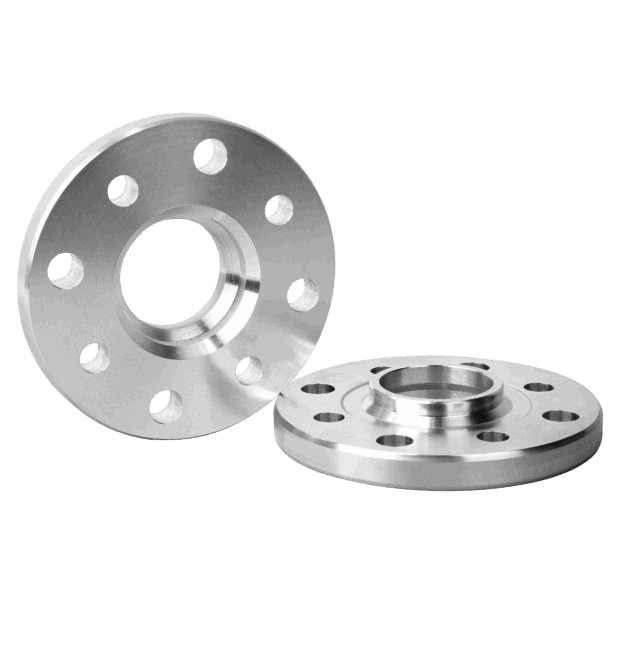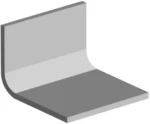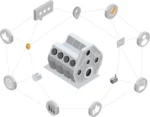Aluminium
Aluminum (Al) is a silvery-white, lightweight metal that can be classified as a non-ferrous metal. It is characterized by high thermal and electrical conductivity and is non-magnetic. The addition of coatings in particular can make aluminum highly resistant to corrosion.
There are different types of aluminum. Pure aluminum has a relatively low strength by nature, which is why it is processed with alloys of metals such as copper, magnesium, manganese or silicon, similar to stainless steel, in order to improve the properties of the aluminum. Depending on the type, aluminium alloys are specialized for different industries or for hardening. You can find more information on this in the table below.
Aluminum is used in numerous industries due to its unique properties such as lightness. Due to its low weight and protection against corrosion and weathering with the help of alloys, it can be used for car bodies or facades, for example. It is also used primarily for packaging due to its low chemical reactions.

The various aluminium types
| Material | DIN | Description | Services |
|---|---|---|---|
| EN AW 2007 | 3.1645 | Due to its good machinability, the material 3.1645 is one of the most frequently used aluminum grades for the turning process, but it is not weldable. | CNC-Machining |
| EN AW 2014 | 3.1255 | Aluminum 3.1255 is easy to machine, impresses with its high hardness and is often used in the aerospace industry. The corrosion resistance of EN AW 2014 is rather low. | CNC-Machining |
| EN AW 2017A | 3.1325 | 3.1325 has high mechanical strength and fatigue resistance. Good corrosion protection is only achieved with EN AW 2017A if it is given an appropriate coating during post-processing. | CNC-Machining |
| EN AW 2024 | 3.1355 | Aluminum 3.1355 has a particularly high strength and fatigue resistance. As a result, it is often used in the aviation industry. | CNC-Machining |
| EN AW 3003 | 3.0517 | The material 3.0517 is an alloy with very good corrosion resistance. With medium mechanical strength, the material is very easy to form and weld. | CNC-Machining |
| EN AW 3105 | 3.0505 | The material 3.0505 is particularly suitable for sheet metal forming due to its good formability and generally versatile mechanical properties. It is also characterized by its resistant corrosion properties. | CNC-Machining, Sheet Metal Forming |
| EN AW 5005 | 3.3315 | 3.3315 is a material with very good corrosion resistance and weldability. It is very suitable for decorative anodizing and for use in various outdoor areas. | CNC-Machining |
| EN AW 5049 | 3.3527 | 3.3527 is suitable for sheet metal forming due to its good formability. The material is characterized by very high corrosion resistance and is also easy to weld. | CNC-Machining, Sheet Metal Forming |
| EN AW 5052 | 3.3523 | EN AW 5052 is an alloy that is known for its very good corrosion resistance. This makes it ideal for shipbuilding in particular. In addition, the alloy has high strength and is also easy to weld. | CNC-Machining, Sheet Metal Processing |
| EN AW 5083 | 3.3547 | Alloy 3.3547 is a non-hardenable aluminum alloy that impresses with its very good corrosion resistance and high strength. The alloy is very easy to weld and can be used for a wide range of applications, e.g. in shipbuilding. | CNC-Machining, Sheet Metal Processing |
| EN AW 5754 | 3.3535 | The alloy EN AW 5754 is characterized by very high corrosion resistance and hardness. This alloy is therefore particularly suitable for industries where high resistance to external influences is required, such as in the automotive industry, but also in shipbuilding or plant and mechanical engineering. With rather average machining properties, 3.3535 has good formability and weldability and is also suitable for anodizing. | CNC-Machining, Sheet Metal Processing |
| EN AW 6005A | 3.3210 | This alloy 3.3210 also has good corrosion resistance and medium-high strength and, like 3.3535, is used in similar industries such as the automotive industry. EN AW 6005A is one of the most commonly used wrought aluminum alloys, with a high silicon content. | CNC-Machining |
| EN AW 6012 | 3.0615 | 3.0615 is an alloy with very good machinability. It is therefore frequently used for machined components in mechanical engineering. EN AW 6012 also has good formability with the aid of heat, but is not suitable for welding. | CNC-Machining |
| EN AW 6060 | 3.3206 | This alloy 3.3206 is particularly suitable for applications with high surface requirements in the mechanical engineering and automotive industries. The material can also be used for decorative purposes due to its good anodizing properties. EN AW 6060 originates from the extrusion sector and is also suitable for applications where strength is not a decisive factor. | CNC-Machining |
| EN AW 6061 | 3.3211 | The material 3.3211 is a very popular aluminum alloy for various applications. It is characterized by good mechanical properties and very good weldability. Due to its high strength, it is particularly suitable for applications that place high demands on the material, such as in the automotive or scaffolding industry, | CNC-Machining, Sheet Metal Processing |
| EN AW 6063 | 3.3206 | The material EN AW 6063 is very similar to EN AW 6060, with the only difference in composition being the slightly higher magnesium content that characterizes EN AW 6063. As a result, both materials are used for similar applications. Like EN AW 6060, EN AW 6063 is therefore suitable for components without high strength requirements. | CNC-Machining |
| EN AW 6082 | 3.2315 | Alloy 3.2315 has very good corrosion resistance, weldability and machinability. This material is therefore suitable for a wide range of applications. Compared to EN AW 6061, EN AW 6082 has almost identical properties, but slightly improved strength values, which means it is increasingly replacing EN AW 6061 in the industry. | CNC-Machining, Sheet Metal Processing |
| EN AW 7020 | 3.4335 | The material EN AW 7020 has very good machinability properties and medium strength, so it is used in industries such as aviation for supporting structures or other welded constructions where high demands are placed on the material. 3.4335 is easy to weld, but has disadvantages in terms of protection against weathering and seawater, making it rather unsuitable for shipbuilding. | CNC-Machining |
| EN AW 7050 | 3.4144 | The material EN AW 7050 is an age-hardenable alloy and can therefore be treated with heat. In contrast to other alloys, 3.4144 has a high proportion of zinc and also copper, which makes it slightly different from EN AW 7020 in chemical terms. The properties of this alloy are largely the same as EN AW 7020, making it ideal for the aerospace industry. | CNC-Machining |
| EN AW 7075 | 3.4365 | The material EN AW 7075 is particularly impressive due to its high strength, toughness, good ductility and fatigue resistance. Due to these properties, it is often used for heavy-duty applications in the aerospace industry. Other properties that are typical of 3.4365 include good machinability and polishability. | CNC-Machining |
Aluminium: Pros and Cons
Pros
Aluminum is primarily known for its low weight. This means that when aluminum is used in cars, for example, better fuel efficiency can be achieved. Another advantage is corrosion protection, which can be increased by the various alloys. This means that aluminum can protect against external influences and can also come into contact with sensitive foods or materials without any problems. In addition, aluminum has high thermal and electrical conductivity, which makes it suitable for electronic components such as printed circuit boards (PCB). Due to the softness of the metal, aluminum can also be easily shaped and thus adapted to all requirements. Finally, the use of aluminum is also interesting due to its good recyclability, as no quality of the material is lost despite recycling.
Cons
The production of aluminum sometimes requires energy-intensive processes, which can increasingly be avoided by using recycled aluminum. In addition, corrosion resistance is limited even with alloys, especially in salty environments such as seawater. Since pure aluminum has low strength compared to other metals, it must be alloyed, which can lead to additional costs. Finally, the difficult weldability of aluminum must also be taken into account. Due to its high thermal conductivity and the formation of an oxide layer, a special alloy must be used to make aluminum weldable.
Further Resources
Book personal meeting
Contact Us
* By submitting the form, you agree to the assemblean privacy policy.


